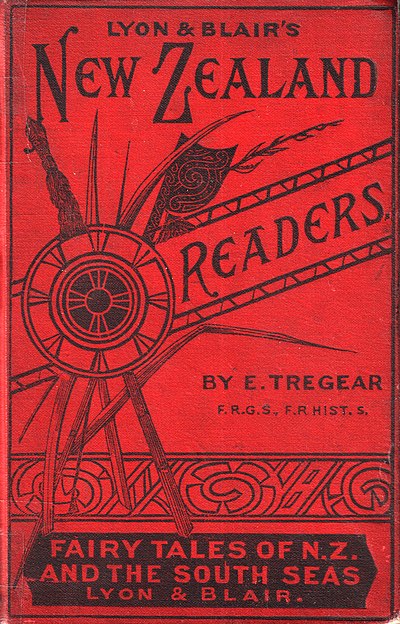Fairy Tales and Folk-Lore of New Zealand and the South Seas
NEW ZEALAND READERS.
FAIRY TALES
AND
FOLK-LORE OF NEW ZEALAND
AND THE SOUTH SEAS.
By E. TREGEAR, F.R.G.S., F.R.Hist.S.

Wellington, N.Z.
LYON & BLAIR, LAMBTON QUAY.
1891.
ALL RIGHTS RESERVED.
CONTENTS.
| PAGES. | |
| The Fairy Fishermen | 1–4 |
| The Fairy Canoe | 5–9 |
| The Winged Ogress | 9–15 |
| The Flower of Lanai | 16–23 |
| The Pet Whale | 23–30 |
| The Coco-Nut Tree | 31–34 |
| The Great Swing | 34–39 |
| The Giant Warrior | 40–44 |
| The Slaying of the Dragon | 44–48 |
| The War of Waters | 48–51 |
| The Hill Fairies | 51–54 |
| The Ironwood Tree | 54–59 |
| The Maiden Swimmer | 60–65 |
| The Shark-God/ | 66–71 |
| The Serpent Woman | 71–77 |
| The Rainbow Maiden | 77–85 |
| The Woman in the Moon | 86–87 |
| The Goddess of Volcanoes | 88–91 |
| Maui the Hero | 92–106 |
| The Fair Voyager | 106–112 |
| The Faithful Wife | 113–116 |
| The Neglected Warning | 117–120 |
| The Water-Kelpies | 121–123 |
| The Celestial Vine | 124–127 |
| The Brother’s Likeness | 127–131 |
| The Ogre’s Captive | 132–135 |
| The Enchanted Water | 135–138 |
| The Stolen Wife | 139–142 |
| The Dancing Fish | 142–145 |
| The Flowers of Paradise | 145–148 |
| The Twin Stars | 148–151 |
| The Fairy of the Fountain | 152–154 |
| The Magic Spear-Point | 155–161 |
| The Spirit of the Cave | 161–164 |
The Vowels in native words are pronounced as follows:—
| a, | like | a in father. |
| e, | {{{1}}}„ | a in Mary. |
| i, | {{{1}}}„ | e in me. |
| o, | {{{1}}}„ | o in pony. |
| u, | {{{1}}}„ | oo in poodle. |
Thus, Kahu is pronounced kah′-hoo, &c., &c.
The native names used in the original legends are often too long for young readers to pronounce, therefore many of them have been shortened in the Lessons. They may be identified in the list on page 165.
ABBREVIATIONS OF PROPER NAMES.
| Aka | is | Akaaka |
| Ao | {{{1}}}„ | Aokeu |
| Aora | {{{1}}}„ | Aorangi |
| Eda | {{{1}}}„ | Edae |
| Hatu | {{{1}}}„ | Hatupatu |
| Iti | {{{1}}}„ | Itieve |
| Kaa | {{{1}}}„ | Kaala |
| Kaha | {{{1}}}„ | Kahalaopuna |
| Kahu | {{{1}}}„ | Kahukura |
| Kai | {{{1}}}„ | Kaaialii |
| Kana | {{{1}}}„ | Te Kanawa |
| Kara | {{{1}}}„ | Te Kararahuara |
| Kari | {{{1}}}„ | Karihi |
| Kauhu | {{{1}}}„ | Kauhuhu |
| Kaulu | {{{1}}}„ | Kaululaau |
| Kiri | {{{1}}}„ | Kiriapi |
| Kotu | {{{1}}}„ | Kotuku |
| Kura | {{{1}}}„ | Kurangaituku |
| Maha | {{{1}}}„ | Mahana |
| Mahu | {{{1}}}„ | Mahuika |
| Mai | {{{1}}}„ | Mailou |
| Malu | {{{1}}}„ | Maluafiti |
| Nana | {{{1}}}„ | Ndandarakai (p. 146) |
| Nana | {{{1}}}„ | Ngana (p. 107) |
| Nuku | {{{1}}}„ | Nukutere |
| Оa | {{{1}}}„ | Oarangi |
| Pata | {{{1}}}„ | Pataariri |
| Piri | {{{1}}}„ | Piriereua |
| Pona | {{{1}}}„ | Ponaturi |
| Rau | {{{1}}}„ | Raumea |
| Roa | {{{1}}}„ | Roangarahia |
| Rora | {{{1}}}„ | Rorandindi-ndavetalevu |
| Rua | {{{1}}}„ | Ruarangi |
| Ruru | {{{1}}}„ | Ruruteina |
| Tane (generally) is Tane | ||
| Tane | is | Tane-ere-tue (p. 49) |
| Tawha | {{{1}}}„ | Tawhaki |
| Teu | {{{1}}}„ | Teuaopokere |
| Tiko | {{{1}}}„ | Tikokura |
| Tini | {{{1}}}„ | Tinirau or Tinilau |
| Tu | {{{1}}}„ | Tutanekai |
| Tutu | {{{1}}}„ | Tutunui |
| Uru | {{{1}}}„ | Urutonga |
| Vao | {{{1}}}„ | Vaotere |
| Vari | {{{1}}}„ | Kahavari |
![]()
This work is in the public domain in the United States because it was published before January 1, 1930.
This work may be in the public domain in countries and areas with longer native copyright terms that apply the rule of the shorter term to foreign works.
![]()
Public domainPublic domainfalsefalse

